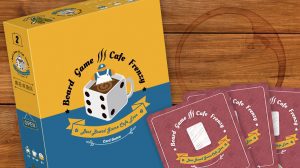Disclosure: Meeple Mountain received a free copy of this product in exchange for an honest, unbiased review. This review is not intended to be an endorsement.
Every year since 2013 AEG (Alderac Entertainment Group) has sponsored an event at Gen Con called Big Game Night. This is a 4 hour long ticketed event which allows attendees to get sneak peeks at upcoming AEG games and walk away with a swag bag containing $50-$100 worth of games. This year AEG released two games “early” by way of Kickstarter so that people who weren’t able to attend Gen Con could take part in the fun. AEG sent us a copy of Whirling Witchcraft so let’s take the lids off our cauldrons and start brewing!
Whirling Witchcraft Overview
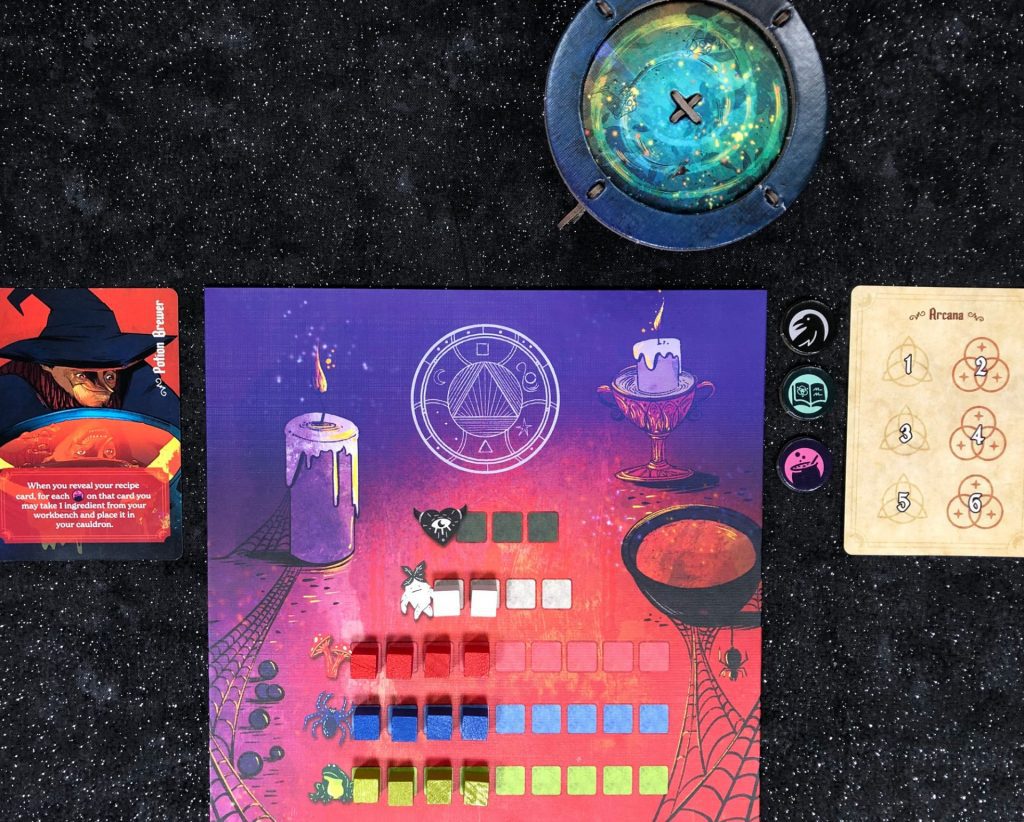
Whirling Witchcraft is a lightweight simultaneous play drafting and engine building game that supports up to 5 people. In Whirling Witchcraft players each take on the persona of a different witch looking to brew potions with ingredients like mandrake root, frogs, mushrooms, spiders, and hearts of darkness (each represented by wooden cubes of different colors). During the game you select recipe cards, brew potions from ingredients on your workbench, and hand off the results to other players (the best witches share with others!). If you give your neighbor more ingredients than will fit on their workbench you get whatever’s left back as points. First to 5 points wins the game. That’s a really quick overview of the game, and doesn’t really do Whirling Witchcraft justice, so let’s dive into the bubbling cauldron and find out how to play.
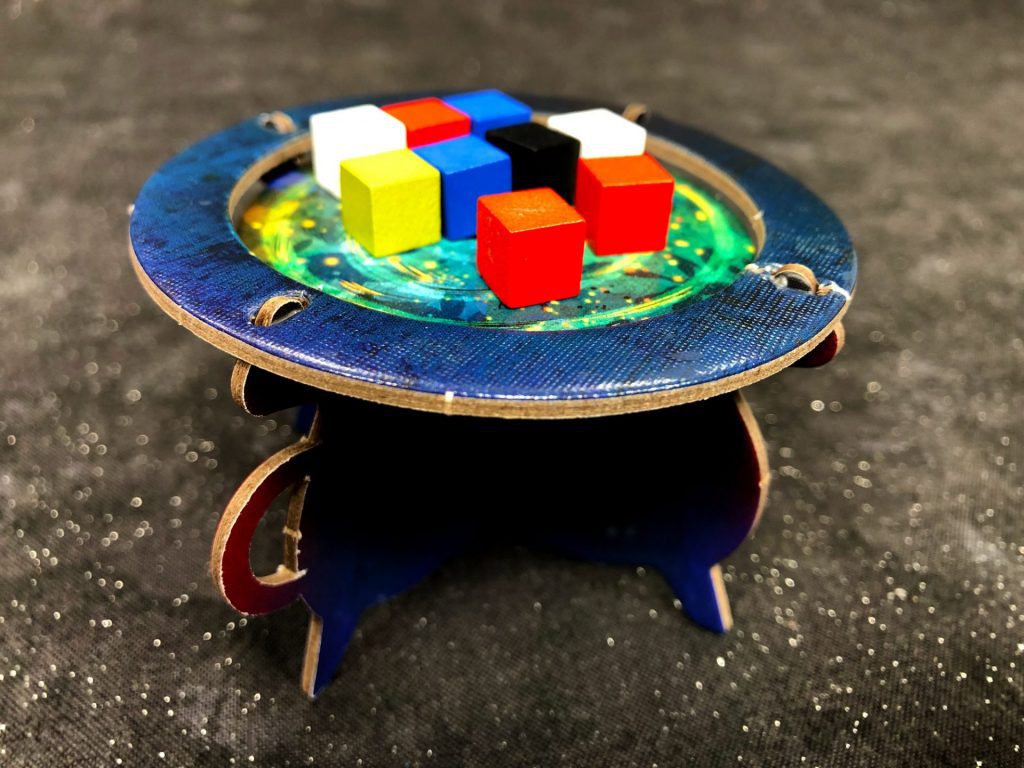
How to play Whirling Witchcraft
Start the game by dealing each player 2 different witch cards, and have them select 1 to keep. These cards might provide a special ability, or a powerful potion recipe unique to that player. First timers can also use the 5 identical witch cards to level the playing field a bit. The back of each witch card displays your starting ingredients, which you’ll pull from the shared supply and place onto your workbench playing board. Deal each player a hand of 4 recipe cards and the game is ready to begin.
Select a Recipe, Produce Ingredients
The goal of Whirling Witchcraft is to be the first player to get to 5 points. You do that by crafting potions which produce ingredients that you pass to the neighbor on your right. At the beginning of the round players will select one of their recipe cards and place it face down on the table. Once everyone is ready, players reveal their cards, and begin crafting potions using ingredients from their workbenches. In general the output of a recipe card will wind up going into your cauldron. However clever players will synergize their recipes; using the output of one recipe to provide ingredients for other recipes, resulting in impressive chains. Be alert because some potions can only be used one way, while some can be flipped upside down when selected.

As you select recipes, your knowledge of the 3 different aspects of potion making will increase accordingly. When selecting your recipe card, take note of Arcana Symbols at the top of the card and move your knowledge marker along the Arcana track by however many symbols appear on your card. When each symbol lands on (or passes) the 2, 4, or 6, space you’ll be able to use that symbol’s matching ability. These abilities allow you to pull ingredients of one type from the supply (instead of your board), place 1 ingredient of any type from the supply directly into your cauldron, or remove up to 2 ingredients from your workbench.
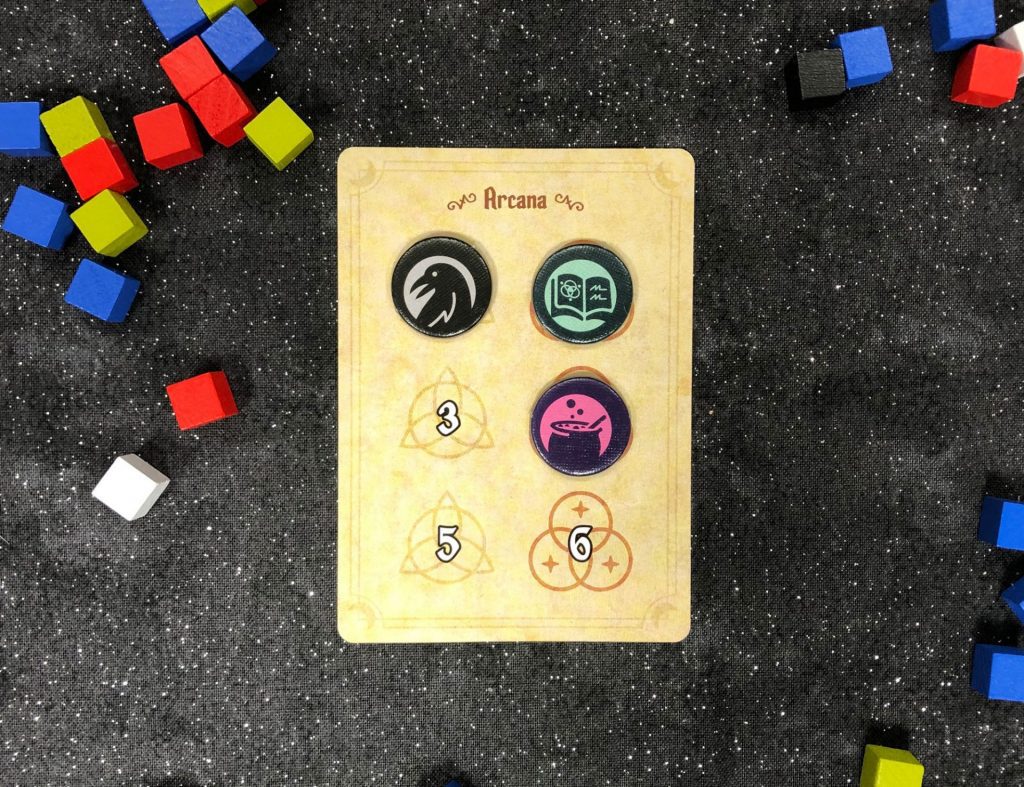
Sharing Your Work, Passing Your Cauldron
After you’ve finished all recipes that you choose to craft, you will take all the ingredients at the bottom of each recipe card, place them into your cauldron, and pass that cauldron to the player on your right. Then you’ll take your 3 remaining recipe cards, draw a new card for that hand, and pass all 4 cards to the player on your left.
When you receive the new cauldron, empty it and add the ingredients to your workbench, from left to right. If any ingredients don’t fit in the provided spaces on your workbench, return any leftover ingredients of that color to the player on your left (the one who gave you the cauldron), where they will be added to that player’s Witch’s Circle (the top of their player board) and count as points.
After this step, determine if any player has 5 points or more, thereby winning the game. If there’s a tie for points, follow the tiebreaker steps until one player wins.
Whirling Witchcraft Final Thoughts
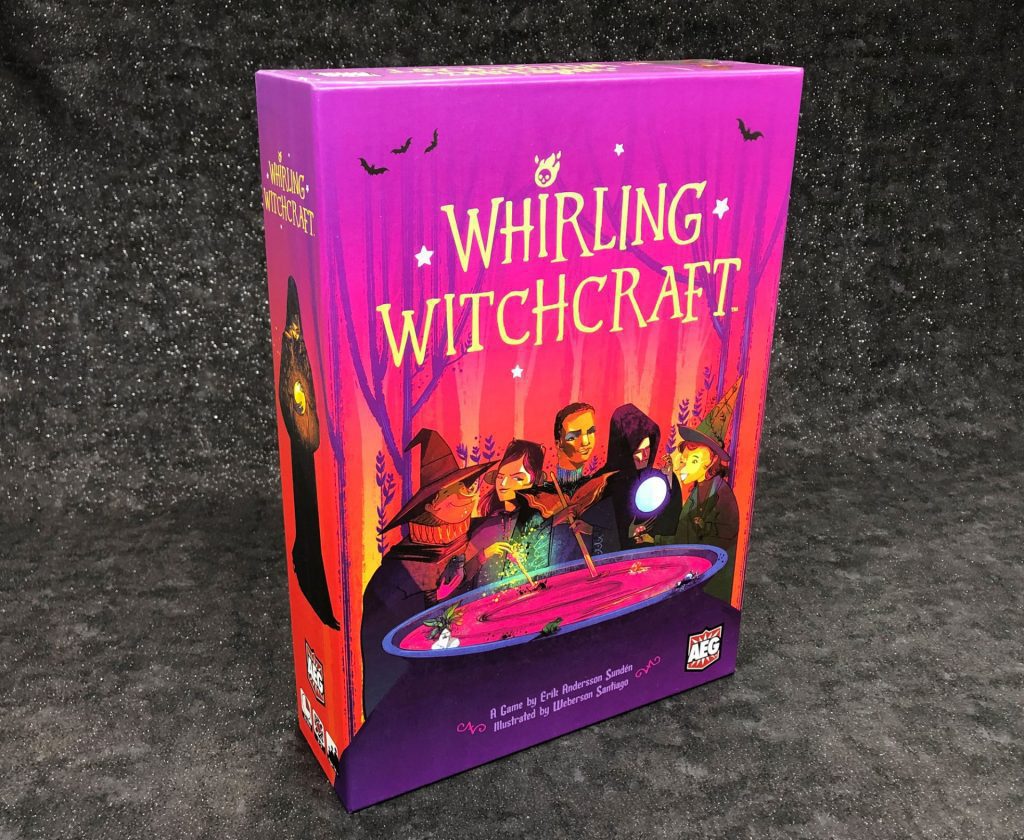
I love lighter games, they’re solidly in my wheelhouse. Long enough to get me interested but not so long that I get bored, easy to explain and teach with interesting things to do and experience. I’m happy to say that Whirling Witchcraft fits the bill.
A month or two ago my friend Tony messaged me out of the blue and told me “Whirling Witchcraft is amazing”. I was familiar with the game from the Kickstarter, but had chosen not to back it at the time. He had received his pledge copy and was playing it for the first time. Tony went on to rave about the game, which definitely gave me regrets about not backing it. Thankfully AEG sent me this review copy and I was able to experience it for myself. While I wouldn’t say I’m over the moon about Whirling Witchcraft, I can tell you that it’s a solid game with lots of great things to say about it.
Let’s start off with the art from Weberson Santiago; it’s just gorgeous, full stop. A great looking box will get my attention every time, and Whirling Witchcraft has this wrapped up. The colors are stunning: vivid and eye-catching, with a unique line style that I’ve not seen before. It’s more reminiscent of comic books than of board games, but it fits the bill here. The components are really cool as well. In addition to the individual game boards, each player gets their own cardboard cauldron with just enough of a lip around the edge to keep your ingredient cubes inside. The cauldrons and boards mirror the vibrant color scheme and add to the otherworldly feel of the game.
Simultaneous play is a challenge to pull off, but when a game can do it right, it can dramatically cut the play time, which means I can play more games in a night. 7 Wonders is an excellent example of a game nailing simultaneous play, but Whirling Witchcraft is great as well. Recipe selection and reveal, producing ingredients, and cauldron and recipe drafting all work smoothly and slash gameplay time.
However in Whirling Witchcraft the simultaneous turns have a slight downside. It’s critical in this game that you pay attention to the player on your left since they’re going to be sending you ingredients. And assuming they get their engine running, you’ll be getting the same ingredients every time. That means you have to be able to use those ingredients in your own recipes. If you’re expecting a load of blue spiders in the cauldron, then you better figure out a way to use them or you’ll be giving points away. But you also have to pay attention to the player on your right. You get your points from them and you want to overwhelm them with ingredients of your own. That means you need to watch what recipes they’re using so that you’re not simply giving them ingredients they can use immediately. Simultaneous play means you have to focus on a lot of things all at once, and this can cost you.
That leads me to my second criticism: 5 points is all it takes to win the game, and in this game that’s not much. Once your own engine is running, you might get 5 points in a single turn. In fact if the luck of the draw doesn’t go your way, it’s possible to be flooded with ingredients you can’t handle by the 3rd or 4th round. That can lead to wildly unpredictable game length: 3 rounds in one game, and 6 or 7 in the next game. Thankfully Whirling Witchcraft plays in 15-20 minutes or so, which means you can just play again. But it can leave a bit of a bad taste in your mouth. I might consider a house rule of 7 points, or even 10.
My last criticism is the only one relating to the design of the game: drafting direction. You pass your cauldron to the right, but your recipe cards to the left. In my first few games I constantly had to return to the rulebook to remember which way to pass each. That could have easily been resolved with icons and arrows in the top right corner of the workbench board.
Whirling Witchcraft isn’t perfect, but it is a hoot: a puzzly game that had my sons bragging about how many cubes they were sending to their brother (or to me), and moaning about not being able to take the ones they were getting. I regularly play games with my 9 and 13 year old sons, but my 11 year old son doesn’t usually enjoy the same games as the three of us. So any game that gets his attention is a win in my book.
So when Mason asks “Daddy, can we play Whirling Witchcraft?” The answer will always be a yes.




